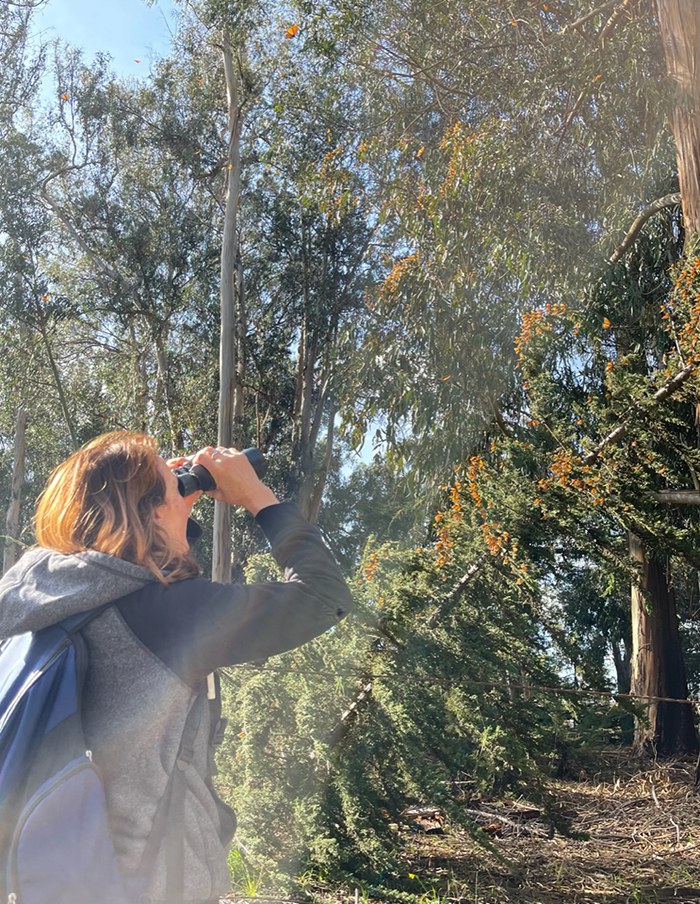Land Trust stewardship director Amanda Egertson just returned from the International Western Monarch Summit in San Luis Obispo, CA. This biannual conference hosted by Western Monarch Advocates gathers people to share, exchange ideas, and learn what others are doing to help in the conservation and restoration of the Western Monarch butterfly. Amanda sits on the Board of Directors of this all volunteer organization to help with the broader regional conservation of the species. Here are a few of her takeaways from the conference.
1. People from all over the world, from all different backgrounds, care about Western monarchs!! Folks from Mexico, Canada, Australia, Hawaii, Rhode Island, Virginia, Kansas, Northern Chumash Tribe, and all the Western states gathered together for a three day conference in San Luis Obispo, CA. They mixed and mingled, shared ideas, stories, and research, learned from one another, and gained motivation, inspiration, and community.
2. The biggest threats to Western monarch butterflies continue to be neonicotinoids found in pesticides, habitat loss and fragmentation of overwintering and migration corridors, and climate change (severe storms in the winter, droughts in the summer, etc). Learn more about these issues here, then read on for how you can help!
3. The most important thing we can do to help monarchs in Oregon is to continue to plant native milkweed and other nectar resources. The Land Trust has been leading the charge to plant native narrowleaf and showy milkweed along with a diverse array of native nectar resources throughout Central Oregon since 2019. These plants provide critical fuel for monarch butterflies passing through our region from late spring through early fall! Get your milkweed seeds today or find native plant lists here.
4. The most amazing sight to see is a cluster of thousands of overwintering monarchs!! Monarchs cluster together to help with thermoregulation. Each cluster creates its own microclimate that protects the butterflies from getting too cold and provides shelter from the elements. Clustering can also help provide protection from predators. Watch our video below to see some of the clusters Amanda watched. Then learn more about the Pismo Beach overwintering site.
5. The coolest new way of tracking migrating monarchs is cardenolide fingerprinting and stable isotope analysis! Cardenolides are the chemicals found in milkweed that make them toxic to many animals. Each species of milkweed has a unique cardenolide fingerprint that can share regional information about where the milkweed was growing. Scientists sample a small portion of a monarch wing (live or dead), and can tell what type of milkweed the monarch ate as a caterpillar and its approximate geographic location. While much work remains in these studies, ~70% of adult monarch butterflies have detectable cardenolide levels (the levels decrease over time after eclosure because they are no longer ingesting cardenolides as adults). Learn more about this research.
Stable isotope analysis measures the naturally occurring stable hydrogen and carbon isotopes in wings of monarchs. This process has proven useful to infer natal origins of Eastern monarch butterflies at continental scales. Again, while these studies need more research and refinement, it is a promising emerging tool! Why is tracking important? Less than 2% of tagged monarchs are recovered and we need A LOT MORE data to help us better understand monarch origins and migration routes if we are going to successfully conserve and help restore their populations. You can help! Take pictures of any monarch butterflies, eggs, or caterpillars you find and document your sightings on the Western Monarch Milkweed Mapper.

Learn more:
- About Western Monarch Advocates
- Visit the Land Trust's monarch and pollinator hub


